MGT540 Case Study: Analyzing Change Management at Lakeland Wonders
VerifiedAdded on 2022/11/03
|14
|3684
|462
Case Study
AI Summary
This case study analysis focuses on the management of change at Lakeland Wonders, a manufacturer of wooden toys. The analysis examines the organizational change project initiated by the new CEO, Cheryl Hailstrom, and the reasons behind it, including the need to meet aggressive sales goals and expand into new markets. The study assesses the appropriateness of Hailstrom's change approach within the organizational context, highlighting her leadership style and the implementation of change strategies. It identifies gaps in the change management process, such as a lack of stakeholder support and an underestimation of the company's culture. Furthermore, the analysis applies a PEST framework to evaluate the external factors influencing the need for change, considering political, economic, social, and technological aspects. The study references various change management models and theories to provide a comprehensive understanding of the challenges and opportunities in the case.
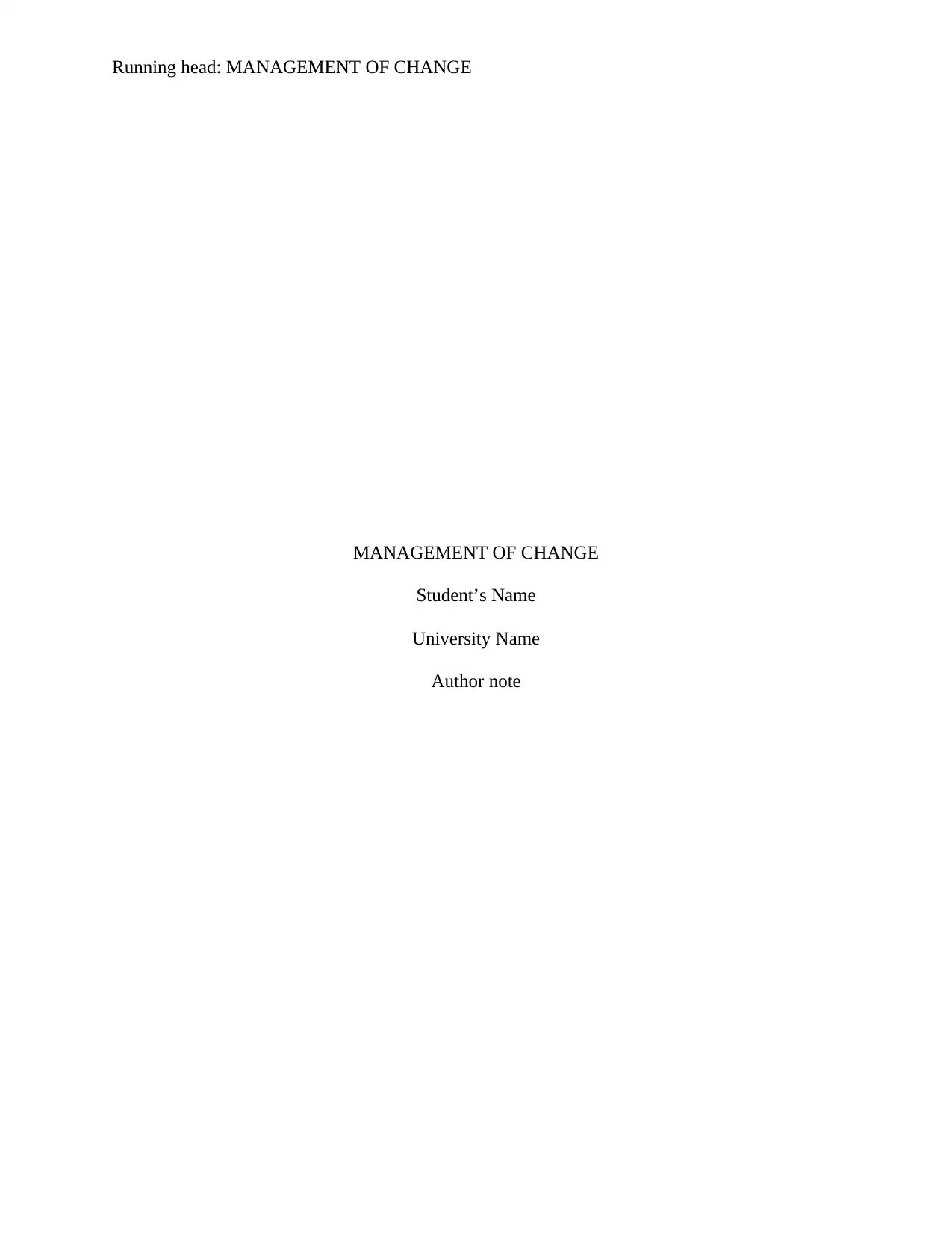
Running head: MANAGEMENT OF CHANGE
MANAGEMENT OF CHANGE
Student’s Name
University Name
Author note
MANAGEMENT OF CHANGE
Student’s Name
University Name
Author note
Paraphrase This Document
Need a fresh take? Get an instant paraphrase of this document with our AI Paraphraser

1MANAGEMENT OF CHANGE
Question 1: Analysis of the nature of change project in Lakeland wonders and reasons for
change
Cheryl Hailstrom, the current CEO of the organization Lakeland Wonders realized the
need for change in the business organization if it wants to maintain its competitiveness in the
twenty first century (Al Saifi, 2015). Cheryl aims to meet the board’s aggressive sales goals and
objectives. It aims to go beyond the core upscale market of Lakeland and launch its
manufactured products into the mid market having an exclusive toy contract with the new
customers. Further, the new CEO, Cheryl Hailstrom had acquired the Bulls-Eye Store’s contract
by selling its manufactured products in the growing mid market. Therefore Cheryl Hailstrom
realized that there were significant changes required in the business organization to meet the
aggressive targets. She had a huge customer counts in her sight and she had a legitimate sense of
urgency. The new CEO Analysis of the nature of change project in Lakeland wonders
implemented change strategies in organization (Babnik et al., 2014)..
As mentioned by Balogun & Hailey, (2008), the need for change in the business
organization was mainly because of the internal reasons as well as outside external changes in
the market o industry scenario. The board of directors of the business organization has set forth
some aggressive growth targets to be achieved by the management. On analysis of the nature of
the internal business scenario, Cheryl Hailstrom had realized that without initiating change in the
internal situations of the business organization, the aggressive targets could not be achieved.
Moreover, it is the nature of Cheryl Hailstrom, to be highly active and she had a personality to be
aggressively pursuing new opportunity (Carlos Pinho, Paula Rodrigues & Dibb, 2014). It is her
Question 1: Analysis of the nature of change project in Lakeland wonders and reasons for
change
Cheryl Hailstrom, the current CEO of the organization Lakeland Wonders realized the
need for change in the business organization if it wants to maintain its competitiveness in the
twenty first century (Al Saifi, 2015). Cheryl aims to meet the board’s aggressive sales goals and
objectives. It aims to go beyond the core upscale market of Lakeland and launch its
manufactured products into the mid market having an exclusive toy contract with the new
customers. Further, the new CEO, Cheryl Hailstrom had acquired the Bulls-Eye Store’s contract
by selling its manufactured products in the growing mid market. Therefore Cheryl Hailstrom
realized that there were significant changes required in the business organization to meet the
aggressive targets. She had a huge customer counts in her sight and she had a legitimate sense of
urgency. The new CEO Analysis of the nature of change project in Lakeland wonders
implemented change strategies in organization (Babnik et al., 2014)..
As mentioned by Balogun & Hailey, (2008), the need for change in the business
organization was mainly because of the internal reasons as well as outside external changes in
the market o industry scenario. The board of directors of the business organization has set forth
some aggressive growth targets to be achieved by the management. On analysis of the nature of
the internal business scenario, Cheryl Hailstrom had realized that without initiating change in the
internal situations of the business organization, the aggressive targets could not be achieved.
Moreover, it is the nature of Cheryl Hailstrom, to be highly active and she had a personality to be
aggressively pursuing new opportunity (Carlos Pinho, Paula Rodrigues & Dibb, 2014). It is her
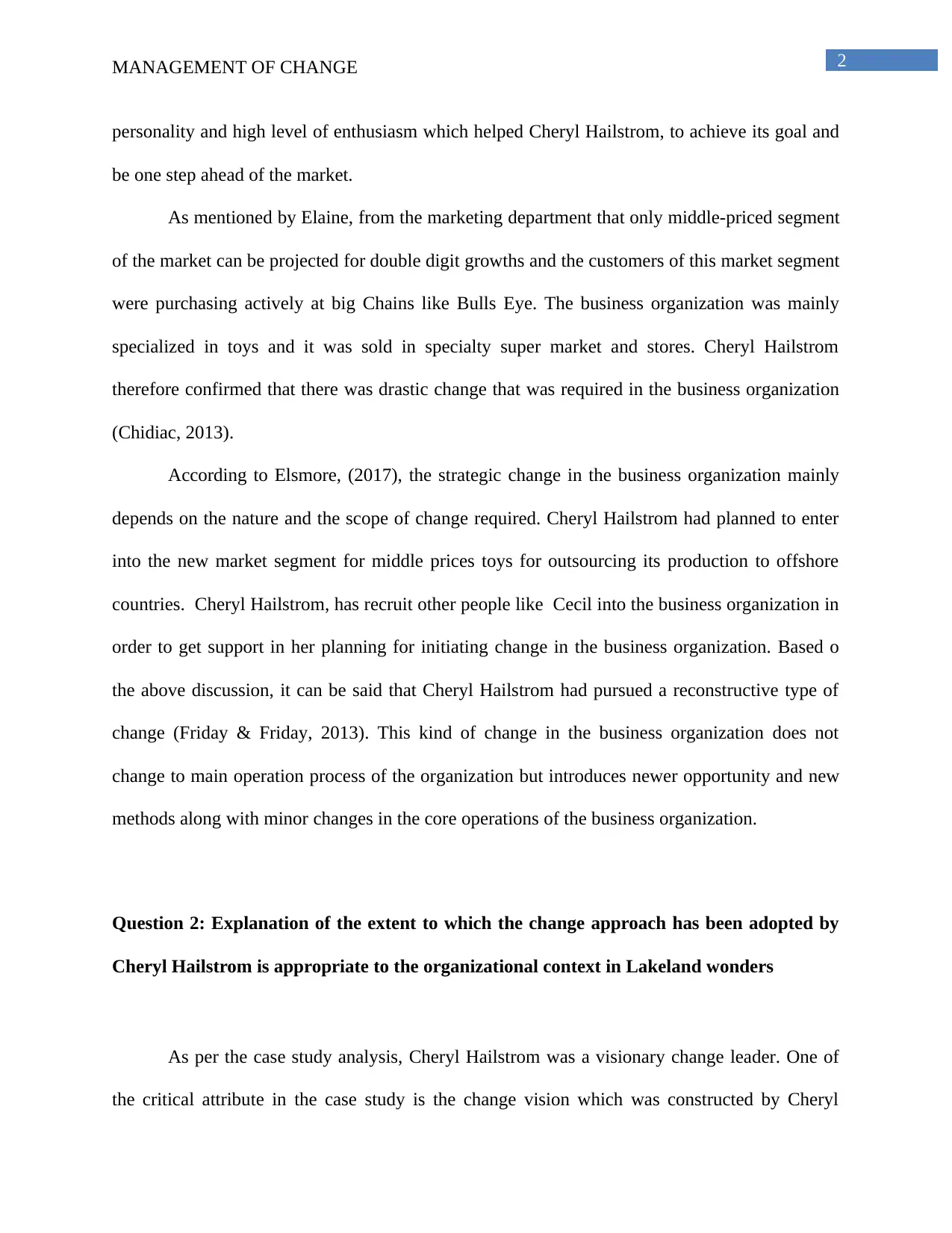
2MANAGEMENT OF CHANGE
personality and high level of enthusiasm which helped Cheryl Hailstrom, to achieve its goal and
be one step ahead of the market.
As mentioned by Elaine, from the marketing department that only middle-priced segment
of the market can be projected for double digit growths and the customers of this market segment
were purchasing actively at big Chains like Bulls Eye. The business organization was mainly
specialized in toys and it was sold in specialty super market and stores. Cheryl Hailstrom
therefore confirmed that there was drastic change that was required in the business organization
(Chidiac, 2013).
According to Elsmore, (2017), the strategic change in the business organization mainly
depends on the nature and the scope of change required. Cheryl Hailstrom had planned to enter
into the new market segment for middle prices toys for outsourcing its production to offshore
countries. Cheryl Hailstrom, has recruit other people like Cecil into the business organization in
order to get support in her planning for initiating change in the business organization. Based o
the above discussion, it can be said that Cheryl Hailstrom had pursued a reconstructive type of
change (Friday & Friday, 2013). This kind of change in the business organization does not
change to main operation process of the organization but introduces newer opportunity and new
methods along with minor changes in the core operations of the business organization.
Question 2: Explanation of the extent to which the change approach has been adopted by
Cheryl Hailstrom is appropriate to the organizational context in Lakeland wonders
As per the case study analysis, Cheryl Hailstrom was a visionary change leader. One of
the critical attribute in the case study is the change vision which was constructed by Cheryl
personality and high level of enthusiasm which helped Cheryl Hailstrom, to achieve its goal and
be one step ahead of the market.
As mentioned by Elaine, from the marketing department that only middle-priced segment
of the market can be projected for double digit growths and the customers of this market segment
were purchasing actively at big Chains like Bulls Eye. The business organization was mainly
specialized in toys and it was sold in specialty super market and stores. Cheryl Hailstrom
therefore confirmed that there was drastic change that was required in the business organization
(Chidiac, 2013).
According to Elsmore, (2017), the strategic change in the business organization mainly
depends on the nature and the scope of change required. Cheryl Hailstrom had planned to enter
into the new market segment for middle prices toys for outsourcing its production to offshore
countries. Cheryl Hailstrom, has recruit other people like Cecil into the business organization in
order to get support in her planning for initiating change in the business organization. Based o
the above discussion, it can be said that Cheryl Hailstrom had pursued a reconstructive type of
change (Friday & Friday, 2013). This kind of change in the business organization does not
change to main operation process of the organization but introduces newer opportunity and new
methods along with minor changes in the core operations of the business organization.
Question 2: Explanation of the extent to which the change approach has been adopted by
Cheryl Hailstrom is appropriate to the organizational context in Lakeland wonders
As per the case study analysis, Cheryl Hailstrom was a visionary change leader. One of
the critical attribute in the case study is the change vision which was constructed by Cheryl
⊘ This is a preview!⊘
Do you want full access?
Subscribe today to unlock all pages.

Trusted by 1+ million students worldwide

3MANAGEMENT OF CHANGE
Hailstrom herself. When it comes to implementing change in the business organization, there are
many arguments based on whether the change approach should be bottom up or top down. It has
been argued by Golembiewski & Carrigan, (2014), that only real leaders who are promoted to
the senior levels of the management can undertake a renewable process in the organization. From
the case study analysis, it has been identified that Cheryl Hailstrom, the new CEO have
impressive credentials which helps her to implement change in the business organization reflect
her real leadership approach. It is believed that Pollack, Costello & Sankaran, (2013), successful
strategic change in the modern business organization is not the result of a ‘revolt of the slaves’,
which comes from the lower level employees. Therefore, it can be said that Cheryl Hailstrom has
undertaken the best change approach that is appropriate to Lakeland wonders.
However, it has been argued Pollack & Pollack, (2015), that business strategies and
change strategies in the business organization must be implemented with an incremental effect.
During the process of implementing change in the business organization, the leaders and the
managers of the business organization need to organize the tasks and prioritize the processes and
procedures of operations while focusing on the speed to change implementation and rapid
decrease in the cost of operations or increase revenue generation. Some of the key elements of
implementing strategy in the business organization are stabilizing the crisis or uncertain
situations, effectively managing the change in the business organization, gaining the support of
the stakeholders, focusing on the target market and re-focusing, restructuring the finance and
prioritizing the critical areas for improvements (Stevens, 2013). Managing change in the business
organization requires high level of time, effort, energy and training.
The vision of the business organization helps the business organization to drive the
organizational strategy and hence emphasize on the change while aligning with the culture of the
Hailstrom herself. When it comes to implementing change in the business organization, there are
many arguments based on whether the change approach should be bottom up or top down. It has
been argued by Golembiewski & Carrigan, (2014), that only real leaders who are promoted to
the senior levels of the management can undertake a renewable process in the organization. From
the case study analysis, it has been identified that Cheryl Hailstrom, the new CEO have
impressive credentials which helps her to implement change in the business organization reflect
her real leadership approach. It is believed that Pollack, Costello & Sankaran, (2013), successful
strategic change in the modern business organization is not the result of a ‘revolt of the slaves’,
which comes from the lower level employees. Therefore, it can be said that Cheryl Hailstrom has
undertaken the best change approach that is appropriate to Lakeland wonders.
However, it has been argued Pollack & Pollack, (2015), that business strategies and
change strategies in the business organization must be implemented with an incremental effect.
During the process of implementing change in the business organization, the leaders and the
managers of the business organization need to organize the tasks and prioritize the processes and
procedures of operations while focusing on the speed to change implementation and rapid
decrease in the cost of operations or increase revenue generation. Some of the key elements of
implementing strategy in the business organization are stabilizing the crisis or uncertain
situations, effectively managing the change in the business organization, gaining the support of
the stakeholders, focusing on the target market and re-focusing, restructuring the finance and
prioritizing the critical areas for improvements (Stevens, 2013). Managing change in the business
organization requires high level of time, effort, energy and training.
The vision of the business organization helps the business organization to drive the
organizational strategy and hence emphasize on the change while aligning with the culture of the
Paraphrase This Document
Need a fresh take? Get an instant paraphrase of this document with our AI Paraphraser
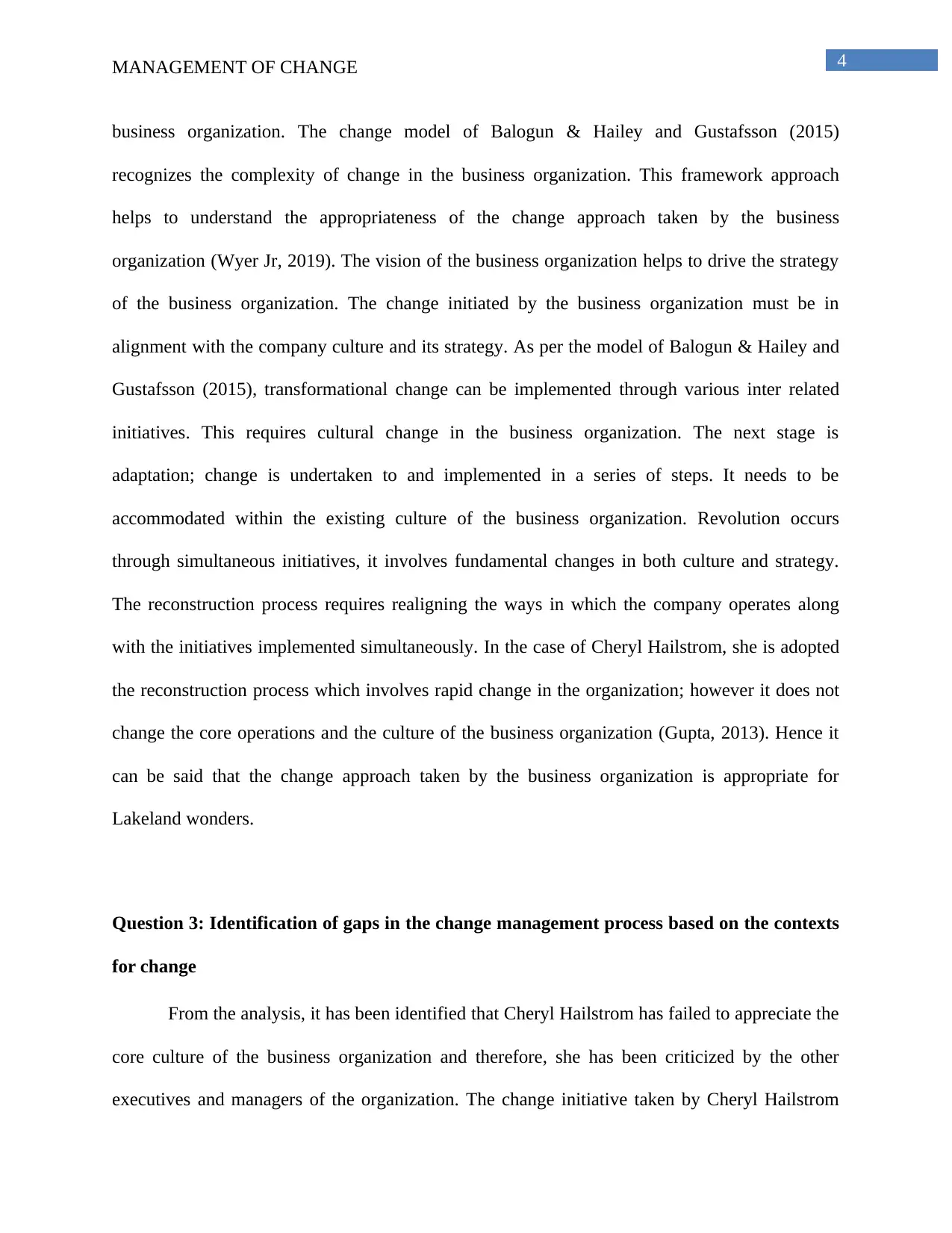
4MANAGEMENT OF CHANGE
business organization. The change model of Balogun & Hailey and Gustafsson (2015)
recognizes the complexity of change in the business organization. This framework approach
helps to understand the appropriateness of the change approach taken by the business
organization (Wyer Jr, 2019). The vision of the business organization helps to drive the strategy
of the business organization. The change initiated by the business organization must be in
alignment with the company culture and its strategy. As per the model of Balogun & Hailey and
Gustafsson (2015), transformational change can be implemented through various inter related
initiatives. This requires cultural change in the business organization. The next stage is
adaptation; change is undertaken to and implemented in a series of steps. It needs to be
accommodated within the existing culture of the business organization. Revolution occurs
through simultaneous initiatives, it involves fundamental changes in both culture and strategy.
The reconstruction process requires realigning the ways in which the company operates along
with the initiatives implemented simultaneously. In the case of Cheryl Hailstrom, she is adopted
the reconstruction process which involves rapid change in the organization; however it does not
change the core operations and the culture of the business organization (Gupta, 2013). Hence it
can be said that the change approach taken by the business organization is appropriate for
Lakeland wonders.
Question 3: Identification of gaps in the change management process based on the contexts
for change
From the analysis, it has been identified that Cheryl Hailstrom has failed to appreciate the
core culture of the business organization and therefore, she has been criticized by the other
executives and managers of the organization. The change initiative taken by Cheryl Hailstrom
business organization. The change model of Balogun & Hailey and Gustafsson (2015)
recognizes the complexity of change in the business organization. This framework approach
helps to understand the appropriateness of the change approach taken by the business
organization (Wyer Jr, 2019). The vision of the business organization helps to drive the strategy
of the business organization. The change initiated by the business organization must be in
alignment with the company culture and its strategy. As per the model of Balogun & Hailey and
Gustafsson (2015), transformational change can be implemented through various inter related
initiatives. This requires cultural change in the business organization. The next stage is
adaptation; change is undertaken to and implemented in a series of steps. It needs to be
accommodated within the existing culture of the business organization. Revolution occurs
through simultaneous initiatives, it involves fundamental changes in both culture and strategy.
The reconstruction process requires realigning the ways in which the company operates along
with the initiatives implemented simultaneously. In the case of Cheryl Hailstrom, she is adopted
the reconstruction process which involves rapid change in the organization; however it does not
change the core operations and the culture of the business organization (Gupta, 2013). Hence it
can be said that the change approach taken by the business organization is appropriate for
Lakeland wonders.
Question 3: Identification of gaps in the change management process based on the contexts
for change
From the analysis, it has been identified that Cheryl Hailstrom has failed to appreciate the
core culture of the business organization and therefore, she has been criticized by the other
executives and managers of the organization. The change initiative taken by Cheryl Hailstrom

5MANAGEMENT OF CHANGE
has scared off the employees who have been working in the organization since long time. It has
also been analyzed that the change approach taken by Cheryl Hailstrom is quick and rapid rather
than step by step incremental procedure. Cheryl Hailstrom has lacked stakeholder support as well
as the boards. As per the literature on change management by Mitchell, (2013), it is suggested
that two theories of business change, Theory E and Theory O based on economic value and
organizational capability respectively. Theory E is based on a hard approach where the value of
the shareholders is considered to be a legitimate measure for success of the organization. On the
other hand, Theory O is a soft approach where the goal of to develop a culture and human
capability through the process of individual and organizational learning, reflecting, obtaining
feedback and undertaking change in the organization (Gupta, 2013). Both of the theories and the
models help to achieve the organizational goals and objectives wither implicitly or explicitly.
It is evident from the case study analysis, that Cheryl Hailstrom, has failed to appreciate
the traditional culture of the business organization and her approach of aggressive change in the
organization is not supported by the employees and the other managers. As explained in the
Theory E, shareholder value is highly critical and Cheryl Hailstrom daily insistence on attaining
to goals and the targets while ensuring growth shows that she is a Theory E change leader. In the
opinion of Pollack, Costello & Sankaran, (2013), Cheryl Hailstrom has ignored one of the most
important stakeholders of the business organization that is the employees. This is the reason why
Cheryl Hailstrom faces stiffness from the employees as she failed to gain the confidence and
trust of the employees regarding the proposed changes. Cheryl Hailstrom has a tendency to
dictate terms on the basis of her thoughts which she thinks is suitable for the business
organization. She insisted upon he employees and the designers to oblige to her requests for
achieving efficiency by enhancing the bonus plan and tried to improve the productivity (Grant,
has scared off the employees who have been working in the organization since long time. It has
also been analyzed that the change approach taken by Cheryl Hailstrom is quick and rapid rather
than step by step incremental procedure. Cheryl Hailstrom has lacked stakeholder support as well
as the boards. As per the literature on change management by Mitchell, (2013), it is suggested
that two theories of business change, Theory E and Theory O based on economic value and
organizational capability respectively. Theory E is based on a hard approach where the value of
the shareholders is considered to be a legitimate measure for success of the organization. On the
other hand, Theory O is a soft approach where the goal of to develop a culture and human
capability through the process of individual and organizational learning, reflecting, obtaining
feedback and undertaking change in the organization (Gupta, 2013). Both of the theories and the
models help to achieve the organizational goals and objectives wither implicitly or explicitly.
It is evident from the case study analysis, that Cheryl Hailstrom, has failed to appreciate
the traditional culture of the business organization and her approach of aggressive change in the
organization is not supported by the employees and the other managers. As explained in the
Theory E, shareholder value is highly critical and Cheryl Hailstrom daily insistence on attaining
to goals and the targets while ensuring growth shows that she is a Theory E change leader. In the
opinion of Pollack, Costello & Sankaran, (2013), Cheryl Hailstrom has ignored one of the most
important stakeholders of the business organization that is the employees. This is the reason why
Cheryl Hailstrom faces stiffness from the employees as she failed to gain the confidence and
trust of the employees regarding the proposed changes. Cheryl Hailstrom has a tendency to
dictate terms on the basis of her thoughts which she thinks is suitable for the business
organization. She insisted upon he employees and the designers to oblige to her requests for
achieving efficiency by enhancing the bonus plan and tried to improve the productivity (Grant,
⊘ This is a preview!⊘
Do you want full access?
Subscribe today to unlock all pages.

Trusted by 1+ million students worldwide
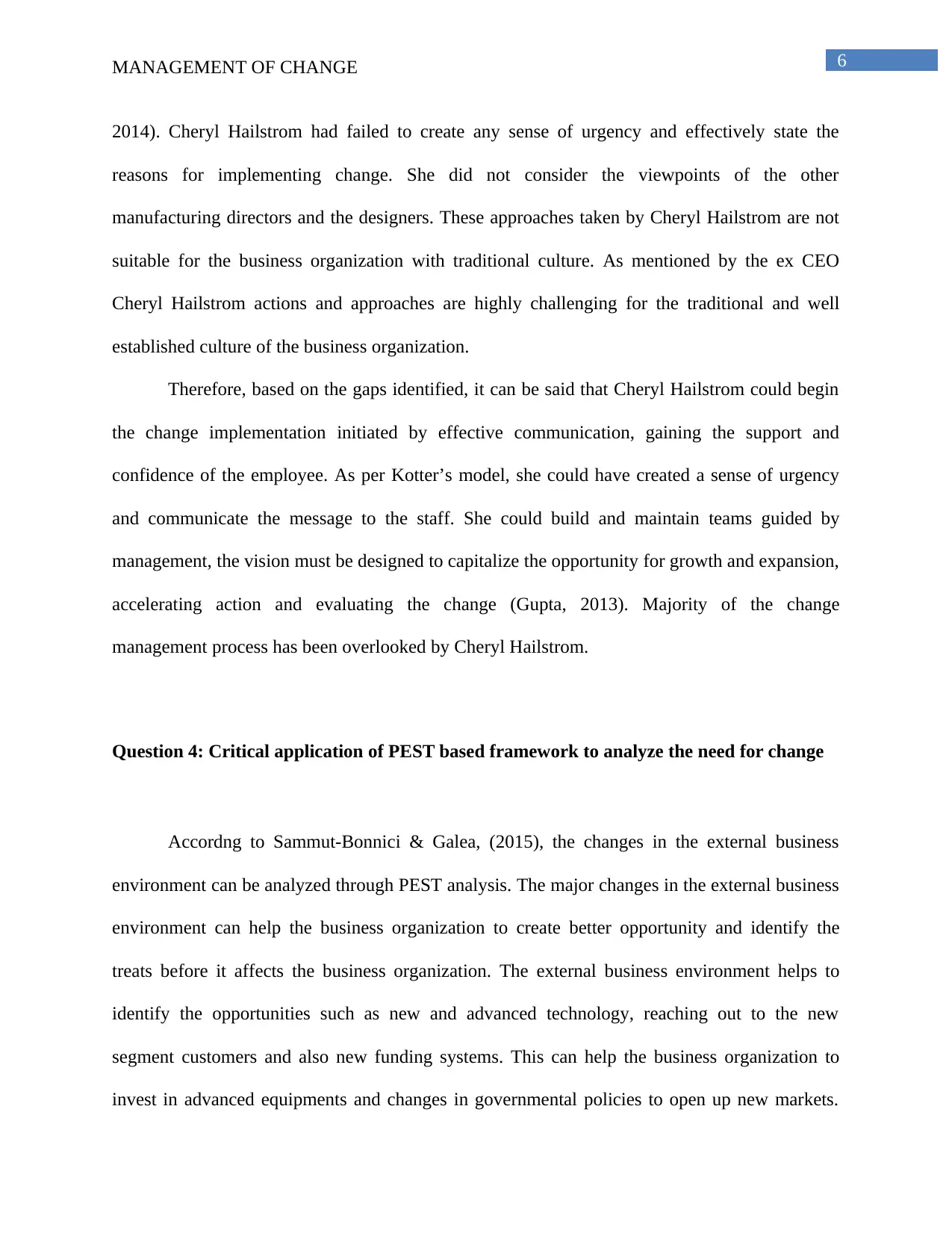
6MANAGEMENT OF CHANGE
2014). Cheryl Hailstrom had failed to create any sense of urgency and effectively state the
reasons for implementing change. She did not consider the viewpoints of the other
manufacturing directors and the designers. These approaches taken by Cheryl Hailstrom are not
suitable for the business organization with traditional culture. As mentioned by the ex CEO
Cheryl Hailstrom actions and approaches are highly challenging for the traditional and well
established culture of the business organization.
Therefore, based on the gaps identified, it can be said that Cheryl Hailstrom could begin
the change implementation initiated by effective communication, gaining the support and
confidence of the employee. As per Kotter’s model, she could have created a sense of urgency
and communicate the message to the staff. She could build and maintain teams guided by
management, the vision must be designed to capitalize the opportunity for growth and expansion,
accelerating action and evaluating the change (Gupta, 2013). Majority of the change
management process has been overlooked by Cheryl Hailstrom.
Question 4: Critical application of PEST based framework to analyze the need for change
Accordng to Sammut‐Bonnici & Galea, (2015), the changes in the external business
environment can be analyzed through PEST analysis. The major changes in the external business
environment can help the business organization to create better opportunity and identify the
treats before it affects the business organization. The external business environment helps to
identify the opportunities such as new and advanced technology, reaching out to the new
segment customers and also new funding systems. This can help the business organization to
invest in advanced equipments and changes in governmental policies to open up new markets.
2014). Cheryl Hailstrom had failed to create any sense of urgency and effectively state the
reasons for implementing change. She did not consider the viewpoints of the other
manufacturing directors and the designers. These approaches taken by Cheryl Hailstrom are not
suitable for the business organization with traditional culture. As mentioned by the ex CEO
Cheryl Hailstrom actions and approaches are highly challenging for the traditional and well
established culture of the business organization.
Therefore, based on the gaps identified, it can be said that Cheryl Hailstrom could begin
the change implementation initiated by effective communication, gaining the support and
confidence of the employee. As per Kotter’s model, she could have created a sense of urgency
and communicate the message to the staff. She could build and maintain teams guided by
management, the vision must be designed to capitalize the opportunity for growth and expansion,
accelerating action and evaluating the change (Gupta, 2013). Majority of the change
management process has been overlooked by Cheryl Hailstrom.
Question 4: Critical application of PEST based framework to analyze the need for change
Accordng to Sammut‐Bonnici & Galea, (2015), the changes in the external business
environment can be analyzed through PEST analysis. The major changes in the external business
environment can help the business organization to create better opportunity and identify the
treats before it affects the business organization. The external business environment helps to
identify the opportunities such as new and advanced technology, reaching out to the new
segment customers and also new funding systems. This can help the business organization to
invest in advanced equipments and changes in governmental policies to open up new markets.
Paraphrase This Document
Need a fresh take? Get an instant paraphrase of this document with our AI Paraphraser
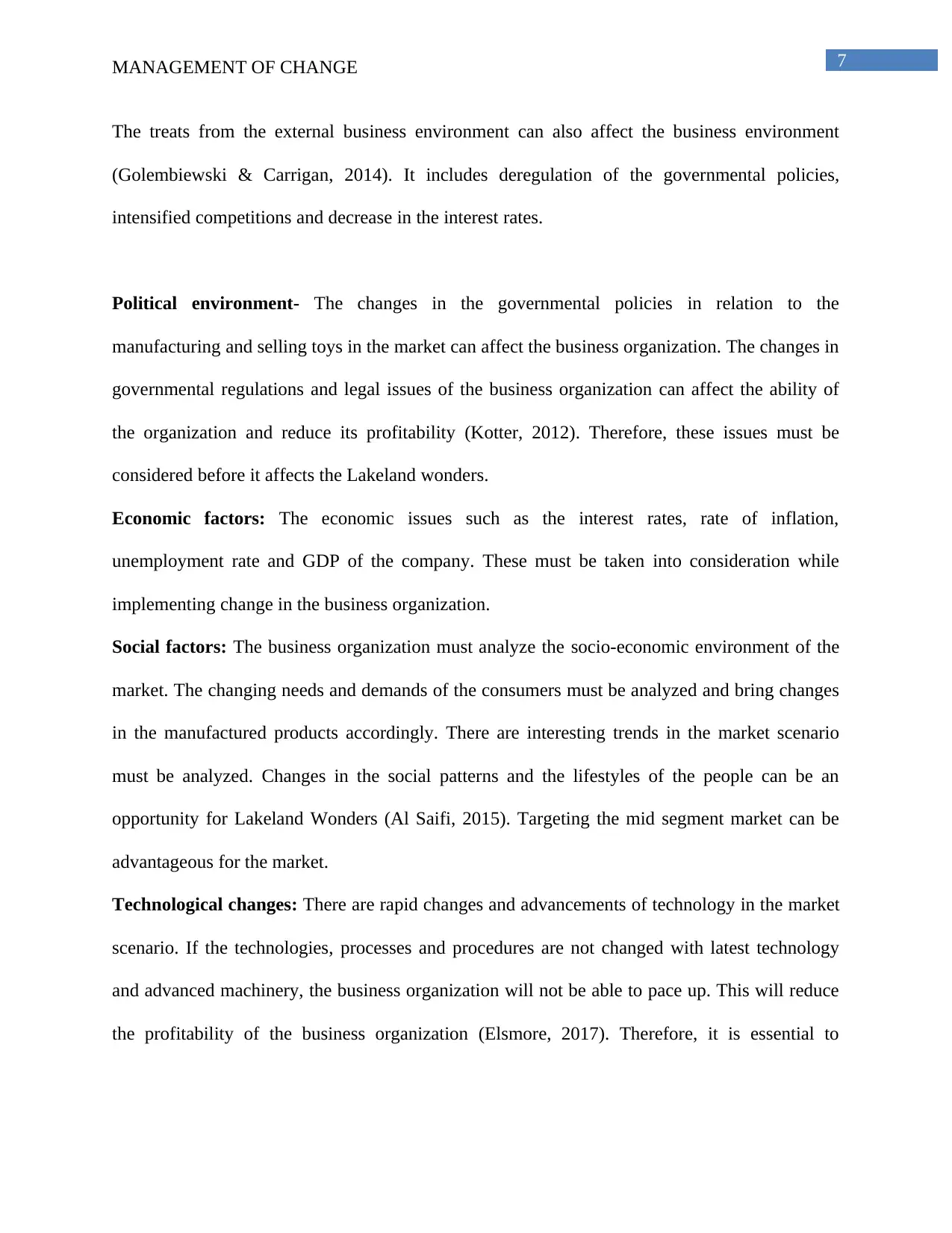
7MANAGEMENT OF CHANGE
The treats from the external business environment can also affect the business environment
(Golembiewski & Carrigan, 2014). It includes deregulation of the governmental policies,
intensified competitions and decrease in the interest rates.
Political environment- The changes in the governmental policies in relation to the
manufacturing and selling toys in the market can affect the business organization. The changes in
governmental regulations and legal issues of the business organization can affect the ability of
the organization and reduce its profitability (Kotter, 2012). Therefore, these issues must be
considered before it affects the Lakeland wonders.
Economic factors: The economic issues such as the interest rates, rate of inflation,
unemployment rate and GDP of the company. These must be taken into consideration while
implementing change in the business organization.
Social factors: The business organization must analyze the socio-economic environment of the
market. The changing needs and demands of the consumers must be analyzed and bring changes
in the manufactured products accordingly. There are interesting trends in the market scenario
must be analyzed. Changes in the social patterns and the lifestyles of the people can be an
opportunity for Lakeland Wonders (Al Saifi, 2015). Targeting the mid segment market can be
advantageous for the market.
Technological changes: There are rapid changes and advancements of technology in the market
scenario. If the technologies, processes and procedures are not changed with latest technology
and advanced machinery, the business organization will not be able to pace up. This will reduce
the profitability of the business organization (Elsmore, 2017). Therefore, it is essential to
The treats from the external business environment can also affect the business environment
(Golembiewski & Carrigan, 2014). It includes deregulation of the governmental policies,
intensified competitions and decrease in the interest rates.
Political environment- The changes in the governmental policies in relation to the
manufacturing and selling toys in the market can affect the business organization. The changes in
governmental regulations and legal issues of the business organization can affect the ability of
the organization and reduce its profitability (Kotter, 2012). Therefore, these issues must be
considered before it affects the Lakeland wonders.
Economic factors: The economic issues such as the interest rates, rate of inflation,
unemployment rate and GDP of the company. These must be taken into consideration while
implementing change in the business organization.
Social factors: The business organization must analyze the socio-economic environment of the
market. The changing needs and demands of the consumers must be analyzed and bring changes
in the manufactured products accordingly. There are interesting trends in the market scenario
must be analyzed. Changes in the social patterns and the lifestyles of the people can be an
opportunity for Lakeland Wonders (Al Saifi, 2015). Targeting the mid segment market can be
advantageous for the market.
Technological changes: There are rapid changes and advancements of technology in the market
scenario. If the technologies, processes and procedures are not changed with latest technology
and advanced machinery, the business organization will not be able to pace up. This will reduce
the profitability of the business organization (Elsmore, 2017). Therefore, it is essential to
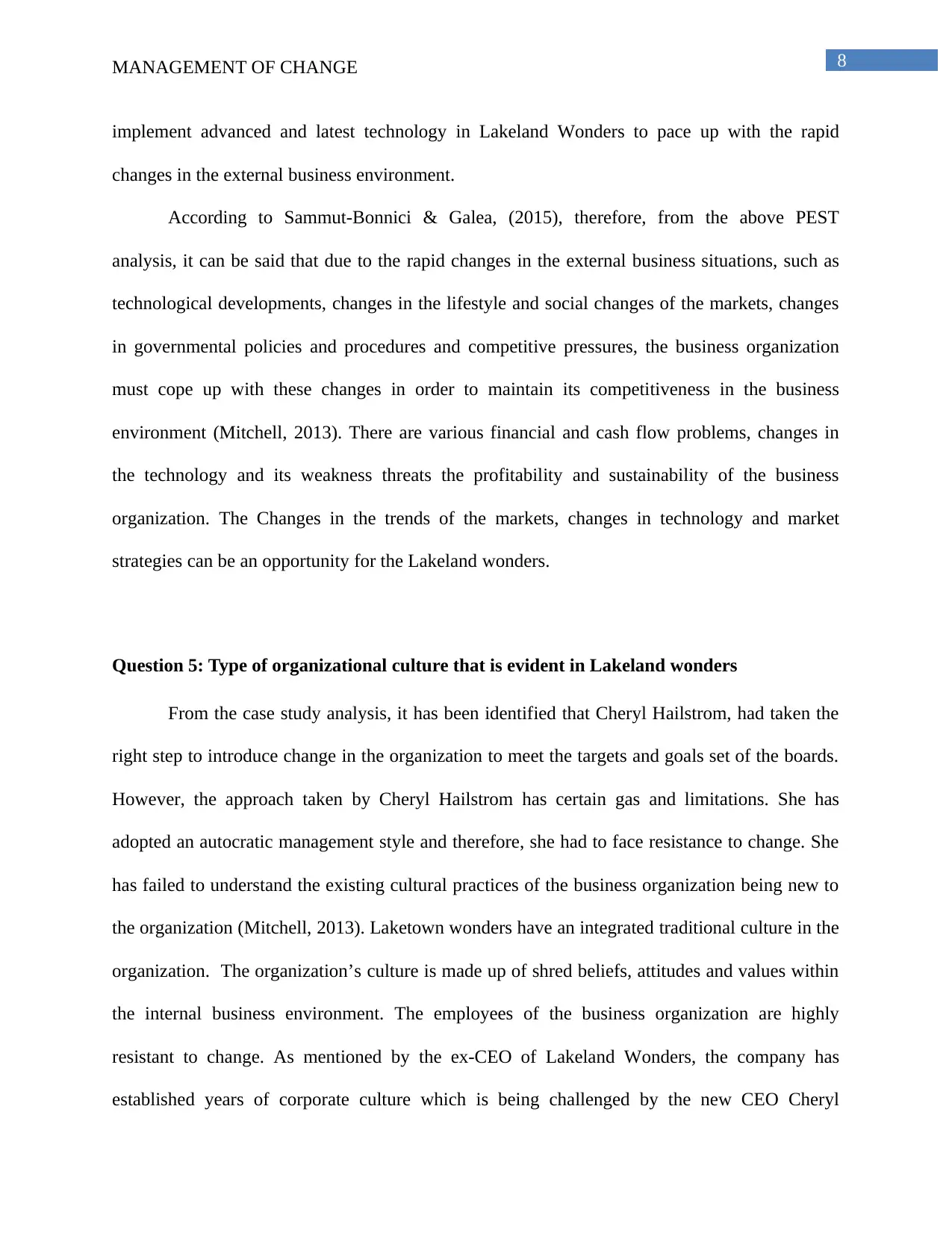
8MANAGEMENT OF CHANGE
implement advanced and latest technology in Lakeland Wonders to pace up with the rapid
changes in the external business environment.
According to Sammut‐Bonnici & Galea, (2015), therefore, from the above PEST
analysis, it can be said that due to the rapid changes in the external business situations, such as
technological developments, changes in the lifestyle and social changes of the markets, changes
in governmental policies and procedures and competitive pressures, the business organization
must cope up with these changes in order to maintain its competitiveness in the business
environment (Mitchell, 2013). There are various financial and cash flow problems, changes in
the technology and its weakness threats the profitability and sustainability of the business
organization. The Changes in the trends of the markets, changes in technology and market
strategies can be an opportunity for the Lakeland wonders.
Question 5: Type of organizational culture that is evident in Lakeland wonders
From the case study analysis, it has been identified that Cheryl Hailstrom, had taken the
right step to introduce change in the organization to meet the targets and goals set of the boards.
However, the approach taken by Cheryl Hailstrom has certain gas and limitations. She has
adopted an autocratic management style and therefore, she had to face resistance to change. She
has failed to understand the existing cultural practices of the business organization being new to
the organization (Mitchell, 2013). Laketown wonders have an integrated traditional culture in the
organization. The organization’s culture is made up of shred beliefs, attitudes and values within
the internal business environment. The employees of the business organization are highly
resistant to change. As mentioned by the ex-CEO of Lakeland Wonders, the company has
established years of corporate culture which is being challenged by the new CEO Cheryl
implement advanced and latest technology in Lakeland Wonders to pace up with the rapid
changes in the external business environment.
According to Sammut‐Bonnici & Galea, (2015), therefore, from the above PEST
analysis, it can be said that due to the rapid changes in the external business situations, such as
technological developments, changes in the lifestyle and social changes of the markets, changes
in governmental policies and procedures and competitive pressures, the business organization
must cope up with these changes in order to maintain its competitiveness in the business
environment (Mitchell, 2013). There are various financial and cash flow problems, changes in
the technology and its weakness threats the profitability and sustainability of the business
organization. The Changes in the trends of the markets, changes in technology and market
strategies can be an opportunity for the Lakeland wonders.
Question 5: Type of organizational culture that is evident in Lakeland wonders
From the case study analysis, it has been identified that Cheryl Hailstrom, had taken the
right step to introduce change in the organization to meet the targets and goals set of the boards.
However, the approach taken by Cheryl Hailstrom has certain gas and limitations. She has
adopted an autocratic management style and therefore, she had to face resistance to change. She
has failed to understand the existing cultural practices of the business organization being new to
the organization (Mitchell, 2013). Laketown wonders have an integrated traditional culture in the
organization. The organization’s culture is made up of shred beliefs, attitudes and values within
the internal business environment. The employees of the business organization are highly
resistant to change. As mentioned by the ex-CEO of Lakeland Wonders, the company has
established years of corporate culture which is being challenged by the new CEO Cheryl
⊘ This is a preview!⊘
Do you want full access?
Subscribe today to unlock all pages.

Trusted by 1+ million students worldwide
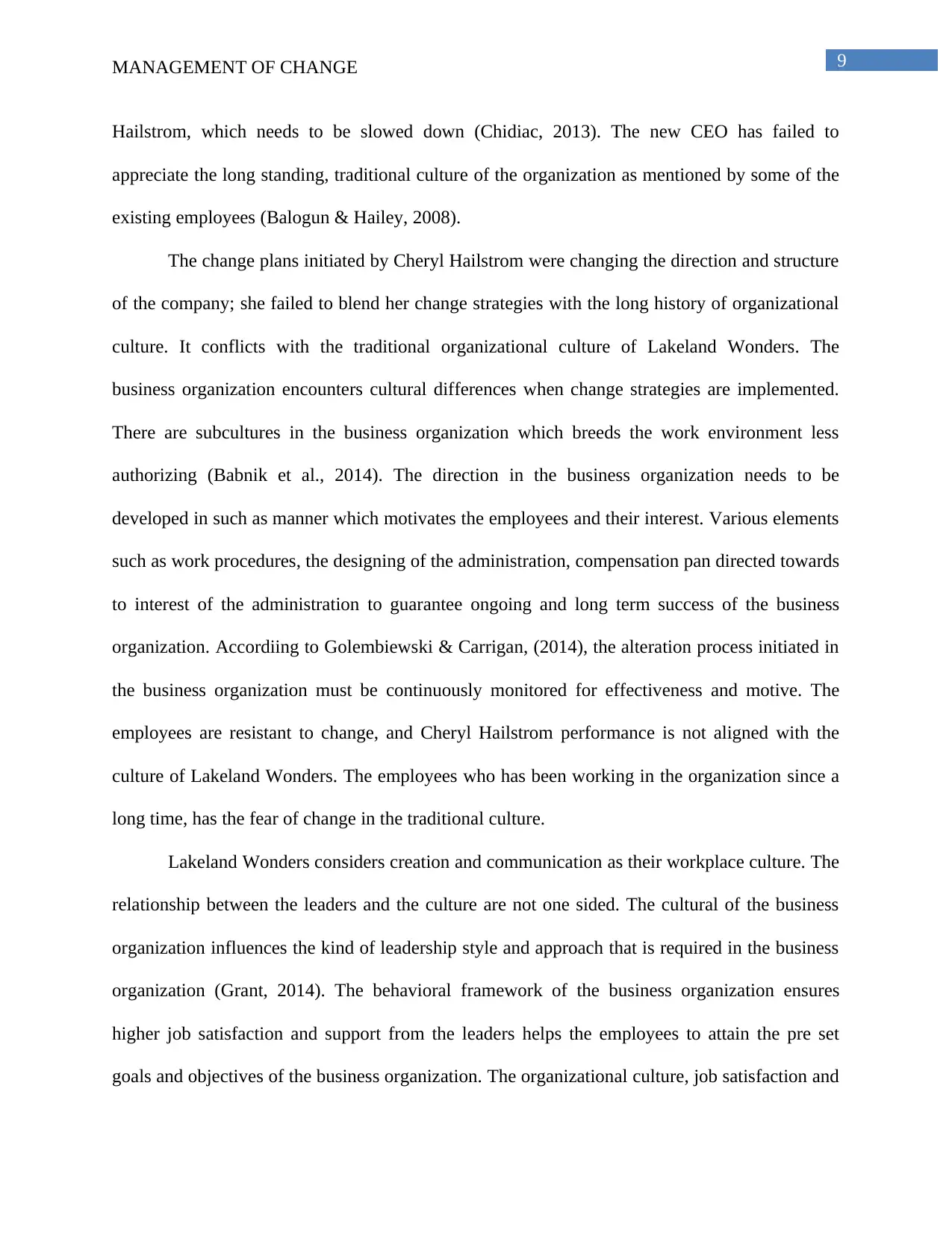
9MANAGEMENT OF CHANGE
Hailstrom, which needs to be slowed down (Chidiac, 2013). The new CEO has failed to
appreciate the long standing, traditional culture of the organization as mentioned by some of the
existing employees (Balogun & Hailey, 2008).
The change plans initiated by Cheryl Hailstrom were changing the direction and structure
of the company; she failed to blend her change strategies with the long history of organizational
culture. It conflicts with the traditional organizational culture of Lakeland Wonders. The
business organization encounters cultural differences when change strategies are implemented.
There are subcultures in the business organization which breeds the work environment less
authorizing (Babnik et al., 2014). The direction in the business organization needs to be
developed in such as manner which motivates the employees and their interest. Various elements
such as work procedures, the designing of the administration, compensation pan directed towards
to interest of the administration to guarantee ongoing and long term success of the business
organization. Accordiing to Golembiewski & Carrigan, (2014), the alteration process initiated in
the business organization must be continuously monitored for effectiveness and motive. The
employees are resistant to change, and Cheryl Hailstrom performance is not aligned with the
culture of Lakeland Wonders. The employees who has been working in the organization since a
long time, has the fear of change in the traditional culture.
Lakeland Wonders considers creation and communication as their workplace culture. The
relationship between the leaders and the culture are not one sided. The cultural of the business
organization influences the kind of leadership style and approach that is required in the business
organization (Grant, 2014). The behavioral framework of the business organization ensures
higher job satisfaction and support from the leaders helps the employees to attain the pre set
goals and objectives of the business organization. The organizational culture, job satisfaction and
Hailstrom, which needs to be slowed down (Chidiac, 2013). The new CEO has failed to
appreciate the long standing, traditional culture of the organization as mentioned by some of the
existing employees (Balogun & Hailey, 2008).
The change plans initiated by Cheryl Hailstrom were changing the direction and structure
of the company; she failed to blend her change strategies with the long history of organizational
culture. It conflicts with the traditional organizational culture of Lakeland Wonders. The
business organization encounters cultural differences when change strategies are implemented.
There are subcultures in the business organization which breeds the work environment less
authorizing (Babnik et al., 2014). The direction in the business organization needs to be
developed in such as manner which motivates the employees and their interest. Various elements
such as work procedures, the designing of the administration, compensation pan directed towards
to interest of the administration to guarantee ongoing and long term success of the business
organization. Accordiing to Golembiewski & Carrigan, (2014), the alteration process initiated in
the business organization must be continuously monitored for effectiveness and motive. The
employees are resistant to change, and Cheryl Hailstrom performance is not aligned with the
culture of Lakeland Wonders. The employees who has been working in the organization since a
long time, has the fear of change in the traditional culture.
Lakeland Wonders considers creation and communication as their workplace culture. The
relationship between the leaders and the culture are not one sided. The cultural of the business
organization influences the kind of leadership style and approach that is required in the business
organization (Grant, 2014). The behavioral framework of the business organization ensures
higher job satisfaction and support from the leaders helps the employees to attain the pre set
goals and objectives of the business organization. The organizational culture, job satisfaction and
Paraphrase This Document
Need a fresh take? Get an instant paraphrase of this document with our AI Paraphraser
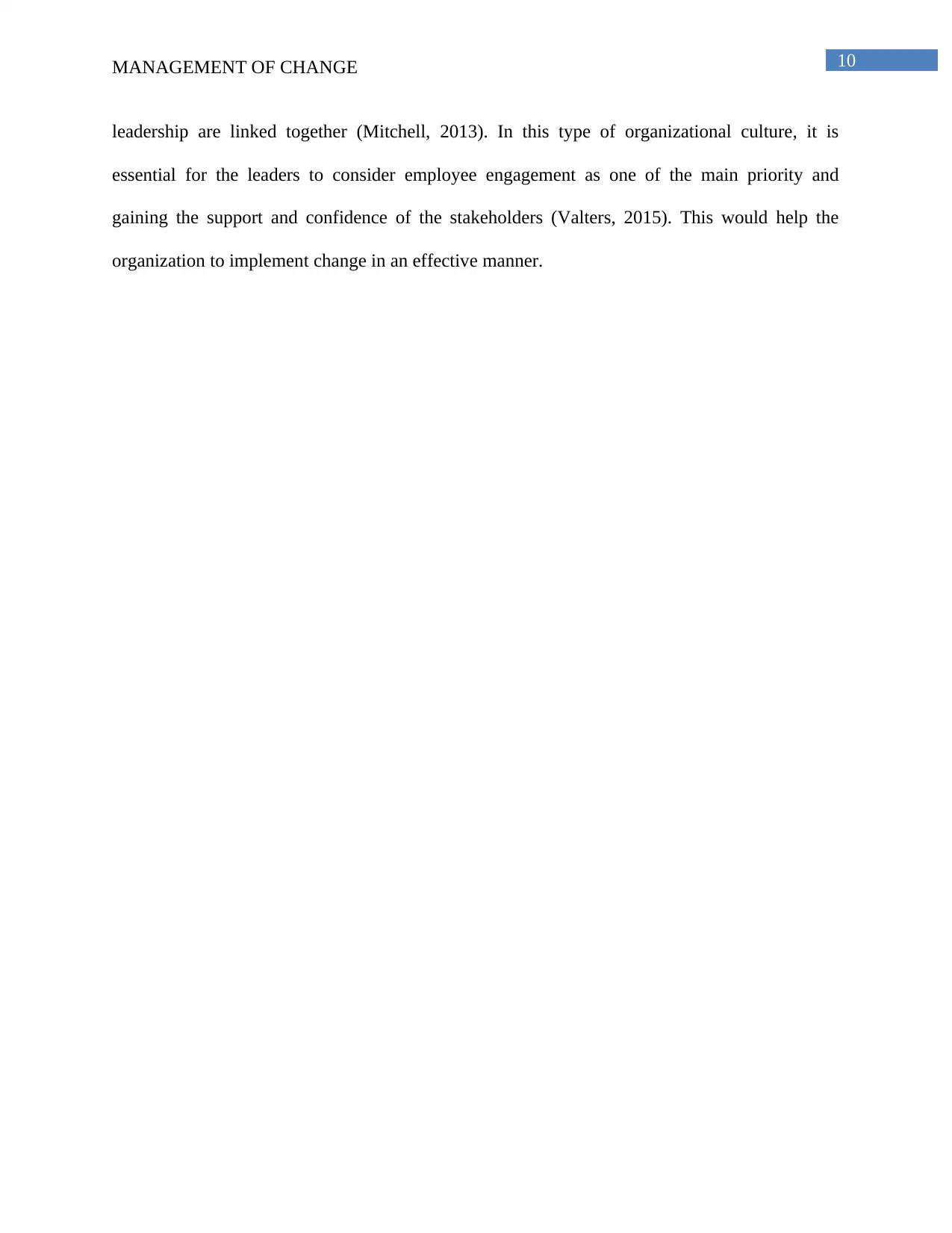
10MANAGEMENT OF CHANGE
leadership are linked together (Mitchell, 2013). In this type of organizational culture, it is
essential for the leaders to consider employee engagement as one of the main priority and
gaining the support and confidence of the stakeholders (Valters, 2015). This would help the
organization to implement change in an effective manner.
leadership are linked together (Mitchell, 2013). In this type of organizational culture, it is
essential for the leaders to consider employee engagement as one of the main priority and
gaining the support and confidence of the stakeholders (Valters, 2015). This would help the
organization to implement change in an effective manner.
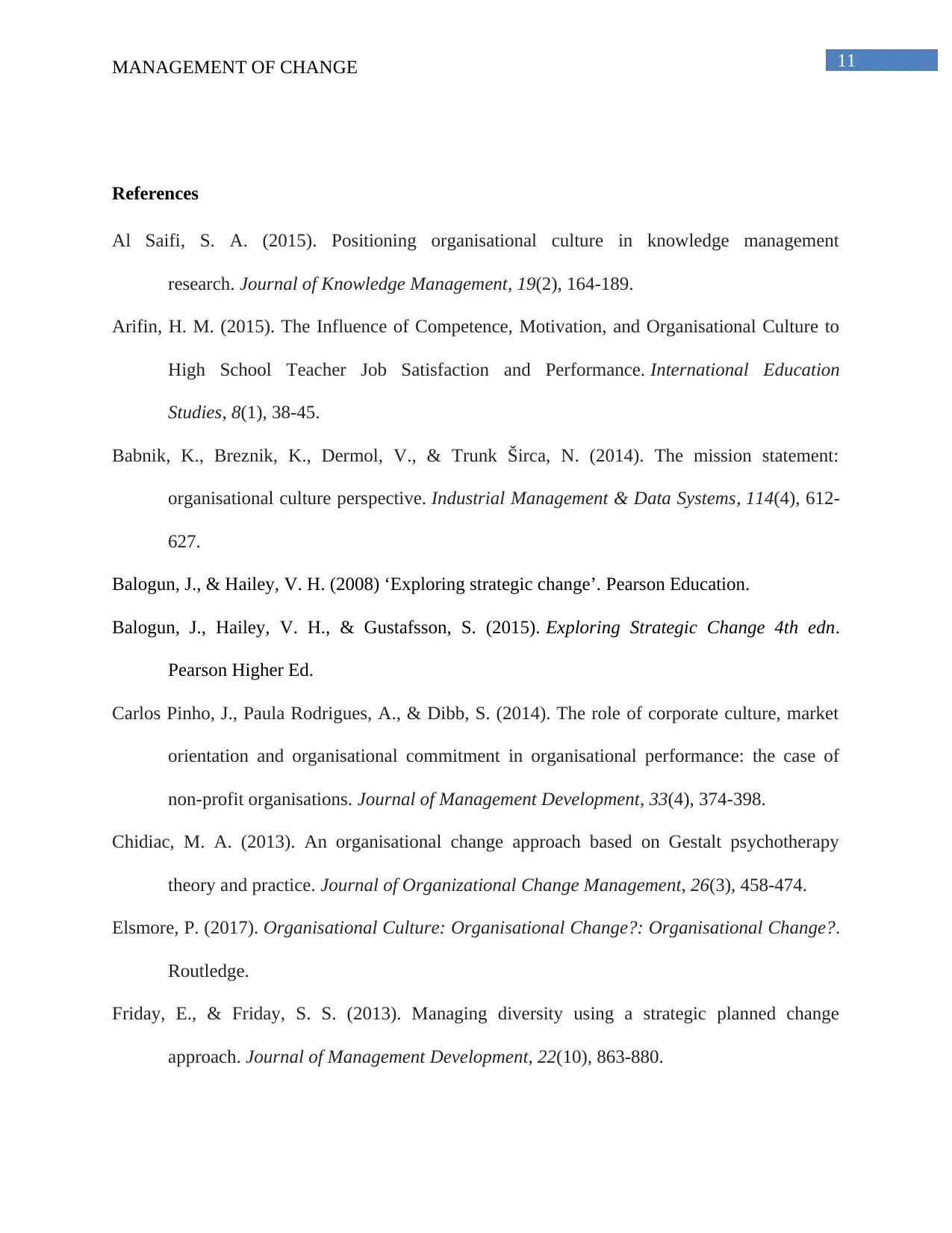
11MANAGEMENT OF CHANGE
References
Al Saifi, S. A. (2015). Positioning organisational culture in knowledge management
research. Journal of Knowledge Management, 19(2), 164-189.
Arifin, H. M. (2015). The Influence of Competence, Motivation, and Organisational Culture to
High School Teacher Job Satisfaction and Performance. International Education
Studies, 8(1), 38-45.
Babnik, K., Breznik, K., Dermol, V., & Trunk Širca, N. (2014). The mission statement:
organisational culture perspective. Industrial Management & Data Systems, 114(4), 612-
627.
Balogun, J., & Hailey, V. H. (2008) ‘Exploring strategic change’. Pearson Education.
Balogun, J., Hailey, V. H., & Gustafsson, S. (2015). Exploring Strategic Change 4th edn.
Pearson Higher Ed.
Carlos Pinho, J., Paula Rodrigues, A., & Dibb, S. (2014). The role of corporate culture, market
orientation and organisational commitment in organisational performance: the case of
non-profit organisations. Journal of Management Development, 33(4), 374-398.
Chidiac, M. A. (2013). An organisational change approach based on Gestalt psychotherapy
theory and practice. Journal of Organizational Change Management, 26(3), 458-474.
Elsmore, P. (2017). Organisational Culture: Organisational Change?: Organisational Change?.
Routledge.
Friday, E., & Friday, S. S. (2013). Managing diversity using a strategic planned change
approach. Journal of Management Development, 22(10), 863-880.
References
Al Saifi, S. A. (2015). Positioning organisational culture in knowledge management
research. Journal of Knowledge Management, 19(2), 164-189.
Arifin, H. M. (2015). The Influence of Competence, Motivation, and Organisational Culture to
High School Teacher Job Satisfaction and Performance. International Education
Studies, 8(1), 38-45.
Babnik, K., Breznik, K., Dermol, V., & Trunk Širca, N. (2014). The mission statement:
organisational culture perspective. Industrial Management & Data Systems, 114(4), 612-
627.
Balogun, J., & Hailey, V. H. (2008) ‘Exploring strategic change’. Pearson Education.
Balogun, J., Hailey, V. H., & Gustafsson, S. (2015). Exploring Strategic Change 4th edn.
Pearson Higher Ed.
Carlos Pinho, J., Paula Rodrigues, A., & Dibb, S. (2014). The role of corporate culture, market
orientation and organisational commitment in organisational performance: the case of
non-profit organisations. Journal of Management Development, 33(4), 374-398.
Chidiac, M. A. (2013). An organisational change approach based on Gestalt psychotherapy
theory and practice. Journal of Organizational Change Management, 26(3), 458-474.
Elsmore, P. (2017). Organisational Culture: Organisational Change?: Organisational Change?.
Routledge.
Friday, E., & Friday, S. S. (2013). Managing diversity using a strategic planned change
approach. Journal of Management Development, 22(10), 863-880.
⊘ This is a preview!⊘
Do you want full access?
Subscribe today to unlock all pages.

Trusted by 1+ million students worldwide
1 out of 14
Related Documents
Your All-in-One AI-Powered Toolkit for Academic Success.
+13062052269
info@desklib.com
Available 24*7 on WhatsApp / Email
![[object Object]](/_next/static/media/star-bottom.7253800d.svg)
Unlock your academic potential
Copyright © 2020–2025 A2Z Services. All Rights Reserved. Developed and managed by ZUCOL.





